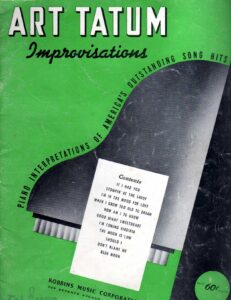Table of Contents
Come join us now, and enjoy playing your beloved music and browse through great scores of every level and styles!
Can’t find the songbook you’re looking for? Please, email us at: sheetmusiclibrarypdf@gmail.com We’d like to help you!
Art Tatum’s arrangement of Youmans’ Tea for Two (sheet music)

Art Tatum is considered by many to have been one of the great pianists of our century, irrespective of genre. Pianists from all fields have acknowledged his phenomenal technical and improvisational abilities. Vladimir Horowitz and Sergei Rachmaninoff are on record as having been astonished by his playing.
Best Sheet Music download from our Library.
Over the years, Tatum recorded several different versions of Vincent Youmans’ Tea for Two, the earliest in 1933. As a matter of fact, each subsequent recorded version embodied substantial changes compared to its predecessors.
As with most of his other transcriptions, this one was never written down or published by Tatum himself. Perhaps because the rhythm is so regular throughout this earliest version, in comparison with later recordings, it automatically became the target of choice for attempts to notate it.
Jed Distler notated the work a few years ago, and a recording of his notation, as somewhat modified, was included in Stephen Mayer’s CD of Tatum favorites issued on the ASV label Brent Edstrom also made an attempt at notation, which was published in “The Tatum Collection” by Hal Leonard Corp. in 1995. There are probably others.
The accuracy of previous attempts at notating such recorded, but unpublished, works (including some of the Ho10witz transcriptions notated by Jan Holeman and Valery Kuleshov) has been limited by the acuteness of the ear of the transcriber.
When the multispeed tape recorder came on the market, it became possible to copy a recording, and then play it back at half-speed, which helped to identify the notes played in rapid passages. These could be further slowed down by dropping to one-quarter speed; but in all of these cases, there was one fundamental disadvantage:
The pitch inexorably dropped an octave each time the tape speed was halved, so that already low-pitched notes became more difficult to identify with each step, and it became more of a problem in some cases to identify accurately the register involved.
With the advent of the personal computer and the multitude of programs which have come on the market in its wake, it was inevitable that sooner or later a program would be introduced which could lower the speed of a recording without dropping its pitch. Such a program is WaveSE™, a Windows™-based sound-editing program, which can do just that It is only through the use of this program that it became possible to produce, with what is believed to be considerable accuracy, the present edition of Art Tatum’s arrangement of Tea for Two. (*)
Please, subscribe to our Library.
If you are already a subscriber, please, check our NEW SCORES’ page every month for new sheet music. THANK YOU!
With a copy of Jed Distler’s sometimes incomplete notation of Tea for Two in hand, it was the editor’s initial intent to try to fill in certain measures which were left blank in Distler’s notation, but after a one-third-speed copy was made of the entire piece, a number of discrepancies were noticed in addition to the blank measures.
Tue use of such a technological aid, of course, does not mean a keen ear and careful listening become unnecessary. Far from it. But at least with a one-third-speed copy (or one reduced even further to one-ninth or one-twenty-seventh speed in order to help illuminate very rapid passages), the individual notes are now more or less isolated for closer inspection and more certain identification.
No one, of course, can guarantee that every note or chord, or every rhythmic intricacy, has been positively identified, especially when we are dealing with a shellac recording sixty-five years old, with its concomitant surface noise, but the editor has done his best to provide as accurate a notation as possible.
Attention should be drawn to the occasional quintuplet figures used by Tatum (see examples in measures 42. 54, 87, 92 and 95), which at very slow speed are usually determined to be rhythmic combinations of 2 + 3 or 3 + 2 rather than an even 5.
Other apparent quintuplet groups were heard under our audio magnifying glass to be very slightly different patterns, such as a combination of two 32d notes and three 16th notes. Where such a pattern was clearly identified, it was so notated in our score. These minor irregularities may have resulted from some unevenness in Tatum’s playing, or they may have been intentional on his part. At any rate, the difference simply cannot be heard in a full-speed performance, which in the recording moves along at a very steady metronome marking of about 168.
Grateful acknowledgment is hereby offered to Jed Distler, whose notation inadvertently started the editor on his quest for the real Tea for Two and provided the requisite outline of the piece and its harmonies, without which it would have been considerably more difficult to proceed with the project; and to Michael Habermann, who graciously devoted considerable time and effort in providing essential criticism of the successive versions of this notation and suggestions for improving its accuracy until both of us came to the realization that it was time to call a halt to further speculation about the few remaining uncertain passages.
It is believed that the result will be worth the serious attention of any pianist, whether jazz or classically oriented.
(*) This was written down by John R. Skinner in 1998. Today, there are some specific software tools to help the hard work of music transcribing, like “Transcribe”.
Browse in the Library:
Or browse in the categories menus & download the Library Catalog PDF:
